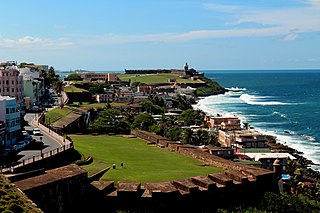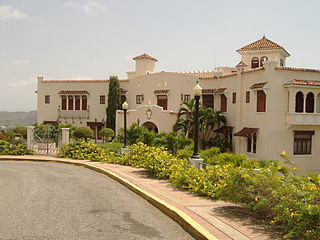
San Juan is the capital city and most populous municipality in the Commonwealth of Puerto Rico, an unincorporated territory of the United States. As of the 2020 census, it is the 57th-largest city under the jurisdiction of the United States, with a population of 342,259. San Juan was founded by Spanish colonists in 1521, who called it Ciudad de Puerto Rico.

Caguas is a city and municipality of Puerto Rico located in the Central Mountain Range of Puerto Rico, south of San Juan and Trujillo Alto, west of Gurabo and San Lorenzo, and east of Aguas Buenas, Cidra, and Cayey. Caguas was founded in 1775. The municipality had a population of 127,244 at the 2020 census.

Ponce is both a city and a municipality on the southern coast of Puerto Rico. The city is the seat of the municipal government.

El Nuevo Día is the newspaper with the largest circulation in Puerto Rico. It was founded in 1909 in Ponce, Puerto Rico, and today it is a subsidiary of GFR Media. Its headquarters are in Guaynabo, Puerto Rico.

Old San Juan is a historic district located at the "northwest triangle" of the islet of San Juan. Its area roughly correlates to the Ballajá, Catedral, Marina, Mercado, San Cristóbal, and San Francisco sub-barrios (sub-districts) of barrio San Juan Antiguo in the municipality of San Juan, Puerto Rico. Old San Juan is the oldest settlement within Puerto Rico and the historic colonial district of the city of San Juan. This historic district is a National Historic Landmark District and is listed on the United States National Register of Historic Places as the Old San Juan Historic District. Several historical buildings and structures, particularly La Fortaleza, the city walls, and El Morro and San Cristóbal castles, have been inscribed in the UNESCO World Heritage Site list since 1983. Historically the mixed use commercial and residential real estate in the main streets like Cristo Street, Fortaleza Street (north) from Tanca Street to the Governor’s Mansion is the most valuable in the area and it has kept its value and increased steadily through several years despite the past economic turmoils.

Antonio ("Toño") Martorell Cardona is a Puerto Rican painter, graphic artist and writer. He regularly exhibits in Puerto Rico and the United States and participates in arts events around the world. He spends his time between his workshops in Ponce, Hato Rey, and New York City, his presentations worldwide and his academic work in Cayey, Puerto Rico.

Museo de Arte de Ponce (MAP) is an art museum located on Avenida Las Américas in Ponce, Puerto Rico. It houses a collection of European art, as well as works by Puerto Rican artists. The museum contains one of the most important Pre-Raphaelite collections in the Western Hemisphere, holding some 4,500 pieces of art distributed among fourteen galleries.

The Institute of Puerto Rican Culture, or ICP, for short, is an institution of the Government of Puerto Rico responsible for the establishment of the cultural policies required in order to study, preserve, promote, enrich, and diffuse the cultural values of Puerto Rico. Since October 1992, its headquarters have been located at the site of the old colonial Spanish Welfare House in Old San Juan. The ICP was created by order of Law Number 89, signed June 21, 1955, and it started operating in November of that year. Its first Executive Director was Dr. Ricardo Alegría.

The Ballajá Barracks is a historic building and former military barracks located in the Ballajá section of Old San Juan, in the city of San Juan, Puerto Rico. It is located close to El Morro and its esplanade, between the Morovis, Beneficiencia and Norzagaray streets. It was built from 1854 to 1864 to house Spanish and Puerto Rican regiments. The Ballajá Barracks were the last large-scale construction project made by the Spanish Crown in the Americas.

The Museo de la Masacre de Ponce is a human rights museum and historic building in Ponce, Puerto Rico. It depicts the history and events surrounding the Ponce massacre, which occurred in broad daylight on Palm Sunday in 1937. The museum is housed inside the building where the event itself occurred, with one of its sections devoted to the Nationalist leader, Pedro Albizu Campos. It also documents the blacklisting of Puerto Rican Nationalists performed by the United States, as well as hosting a considerable number of photos from the Nationalist era.

The Panteón Nacional Román Baldorioty de Castro is a tract of land in Barrio Segundo of the city of Ponce, Puerto Rico, originally designed as the city's cemetery, but later converted into what has come to be a famous burial place. Established in 1842, it is Puerto Rico's first national pantheon. It is the only cemetery dedicated as a museum in Puerto Rico and the Caribbean. Prior to being dedicated as a Panteón Nacional, it was known as Cementerio Viejo or as Cementerio Antiguo de Ponce, and is listed under that name on the U.S. National Register of Historic Places. The Pantheon is named after Román Baldorioty de Castro, a prolific Puerto Rican politician, and firm believer of Puerto Rican autonomy and independence. His remains are located here. The Pantheon also houses a small museum about the history of autonomism in the Island, and it is currently used both as a park and a venue for the expression of culture and the arts. It is called the Museo del Autonomismo Puertorriqueño.

The Museo de la Música Puertorriqueña is a museum in Ponce, Puerto Rico, that showcases the development of Puerto Rican music, with displays of Taíno, Spanish, and African musical instruments that were played in the romantic danza genre, the favorite music of 19th-century Puerto Rican high society, as well as the more African-inspired bomba and plena styles. Also on display are memorabilia of composers and performers. The Museum traces the rich musical history of Puerto Rico through memorabilia of prominent musicians and displays of the musical instruments associated with the three genres of music that originated in this Caribbean island.

The Ponce High School is public educational institution in Ponce, Puerto Rico, offering grades nine through twelve. The school's main building is a historic structure located on Cristina Street, in the Ponce Historic Zone. From its beginning the school has secured a unique place in Puerto Rico's educational history. Of over 3,000 schools erected in Puerto Rico in the first quarter of the twentieth century, Ponce High was the largest, "at a time enrolling more students than all the other Puerto Rico high schools combined", and for many years enrolling more students than any other high school in Puerto Rico. The cost of the building in 1915 dollars was $150,000 USD. The building was listed on the U.S. National Register of Historic Places on 4 August 1987. The school has the only diamond-level DECA chapter in Puerto Rico. The Ponce High School building is "among the most important public buildings ever built in Puerto Rico." The school is the oldest continuously-operating high school in Puerto Rico.

Museo Castillo Serrallés, a.k.a. Museo de la Caña y el Ron, is an agricultural museum in the city of Ponce, Puerto Rico, that showcases the history of sugar cane, its derivative rum industry, and their impact in the economy of Puerto Rico. The most notorious feature of the museum is the building it occupies. The building is a large four-story structure built in the 1930s for the owner of Ponce's Destileria Serralles, one of Puerto Rico's largest rum distilleries. The distillery was once also home to Puerto Rico's largest sugar-factory called Central Mercedita, producers of the Snow White sugar brand. The building, known as Castillo Serrallés, was designed by Pedro Adolfo de Castro in 1930 in the Spanish Colonial Revival style.
The following is a timeline of the history of the city of Ponce, Puerto Rico.

Museo Parque de Bombas is a museum located inside the historic Parque de Bombas in the Ponce Historic Zone in Ponce, Puerto Rico.

Fundación Biblioteca Rafael Hernández Colón is a gubernatorial library and museum that records the political life of three-term governor of Puerto Rico, Rafael Hernández Colón. It was founded in 1992 and in September 2015 it moved to its current location at the southeast corner of Calle Mayor and Calle Castillo in Ponce, Puerto Rico, in the Ponce Historic Zone.

Suzi Ferrer, also known as Sasha Ferrer, was a visual artist based in San Juan, Puerto Rico from the mid-1960s to 1975. She is known for her transgressive, irreverent, avant-garde, art brut and feminist work.


















